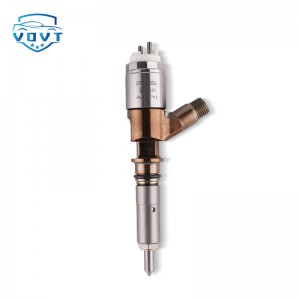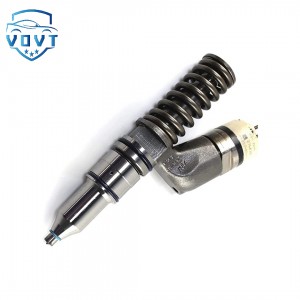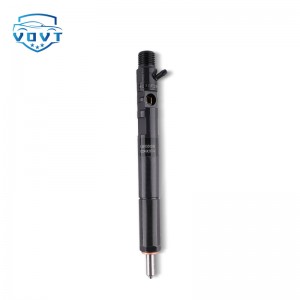New High Quality Diesel Injector 166-0149 170-5240 10R-0963 10R-9530 170-5252 For CAT C12
Products Description
| Reference. Codes | C12 |
| Application | C12 |
| MOQ | 4PCS |
| Certification | ISO9001 |
| Place of Origin | China |
| Packaging | Neutral packing |
| Quality Control | 100% tested before shipment |
| Lead time | 7~10 working days |
| Payment | T/T, L/C, Paypal, Western Union, MoneyGram or as your requirement |
What are the common faults of automobile fuel injectors?
Mechanical wear and blockage faults
1. Carbon deposits or impurities block the spray hole
Reason:
Poor fuel quality (containing impurities and colloids), carbon deposits form at the spray hole after long-term use.
Under the high temperature environment of the engine, the unsaturated components in the fuel oxidize and polymerize, and adhere to the inner wall of the spray hole.
Performance:
The amount of fuel injection is reduced, the mixture is too lean, resulting in reduced engine power and unstable idle speed.
In case of partial blockage, intermittent cylinder loss may occur, and black smoke may come out of the exhaust pipe.
In extreme cases, the spray hole is completely blocked, the corresponding cylinder does not work, and the vehicle cannot start.
2. The injector valve body is stuck
Reason:
Carbon deposits or metal debris jam the valve core (needle valve or ball valve), causing the valve to be unable to open or close completely.
The water in the fuel corrodes the valve body, causing the moving parts to rust and jam.
Performance:
Incomplete opening: insufficient fuel injection, engine acceleration is weak, and fuel consumption increases.
Incomplete closure: Fuel continues to drip (even when the ECU command is closed), resulting in excessive mixture, idle jitter, and black smoke from the exhaust.
Sealing failure type faults
1. Aging/damage of the injector seal
Reason:
The rubber seal is soaked in fuel and affected by high temperature for a long time, and its elasticity decreases and cracks.
Improper operation during disassembly and cleaning (such as excessive force) causes the seal to deform.
Performance:
Fuel leaks into the intake manifold or outside the engine, which may cause the odor of fuel vapor.
Leakage causes the fuel pressure to drop, the engine is difficult to start, and in severe cases, "flooding" (too much fuel in the cylinder) occurs.
2. Wear of the needle valve sealing surface
Reason:
Long-term high-frequency opening and closing, the contact surface between the needle valve and the valve seat forms a dent due to impact wear.
Hard particles in the fuel (such as metal chips) wash the sealing surface, causing scratches.
Performance:
The seal is not tight when closed, and fuel drips, resulting in unstable idle speed and increased fuel consumption.
During cold start, the engine wear may be aggravated by the dilution of the engine oil by the fuel ("wet wall effect").
3. Circuit and electromagnetic faults
1. Solenoid valve coil fault
Cause:
The coil is short-circuited or disconnected due to moisture, or the insulation layer is aged due to long-term high temperature.
Excessive current (such as ECU driver module failure) burns the coil.
Performance:
The injector does not work at all, the corresponding cylinder is missing, and the engine shakes violently.
The OBD fault code shows "injector circuit open/short circuit" (such as P0201-P0204).
2. Poor contact of the wiring harness plug
Cause:
The plug is oxidized, loose or water-infiltrated, resulting in interruption of signal transmission.
Vibration wears the wiring harness, causing the internal wire to break ("hidden open circuit").
Performance:
Intermittent cylinder missing, the engine fault light is on and off.
High-speed driving or bumpy roads may suddenly interrupt the power, causing safety hazards.
Other common problems
1. Faults caused by abnormal fuel pressure
Reason:
The fuel pump pressure is insufficient or the fuel filter is clogged, resulting in the actual injection amount of the injector being lower than the design value.
The fuel pressure regulator is faulty, causing the system pressure to be too high (which may cause the injector to overload and leak).
Performance:
Insufficient power, slow acceleration, and in severe cases, the maximum vehicle speed cannot be reached.
Excessive pressure may cause fuel to spray out from the sealing ring, posing a risk of fire.
2. Poor fuel atomization
Reason:
The nozzle hole wears out (such as long-term use of inferior fuel for flushing), causing the fuel to spray out in a columnar shape rather than a mist.
The internal oil channel of the injector is clogged, the fuel flow is blocked, and the atomization energy is insufficient.
Performance:
Incomplete combustion, increased fuel consumption, and excessive exhaust emissions (increased HC and CO content).
Unatomized fuel flushes the cylinder wall, dilutes the engine oil, and aggravates piston ring wear.
Fault prevention and maintenance suggestions
Use high-quality fuel: reduce impurities and colloids, and reduce the probability of carbon deposits.
Clean the injector regularly: perform non-disassembly cleaning every 20,000-30,000 kilometers. If it is severely blocked, it needs to be disassembled and ultrasonically cleaned.
Replace high-quality fuel filters: It is recommended to replace them every 10,000-20,000 kilometers to prevent impurities from entering the injector.
Avoid long-term idling or short-distance driving: reduce carbon deposits caused by incomplete combustion of fuel.
Timely deal with circuit hazards: regularly check the wiring harness plug to avoid water ingress or oxidation.
If the vehicle is found to have symptoms such as idle jitter, weak acceleration, and abnormal fuel consumption, it is recommended to use professional equipment to detect the working status of the injector as soon as possible to avoid the expansion of the fault.





















